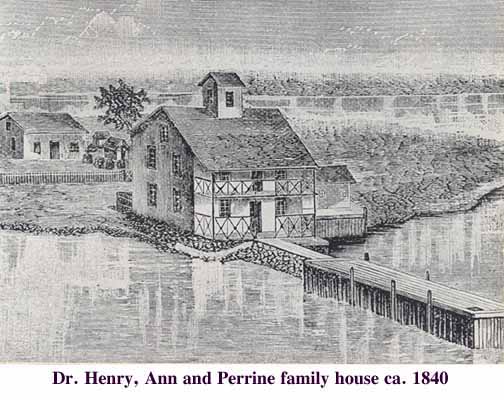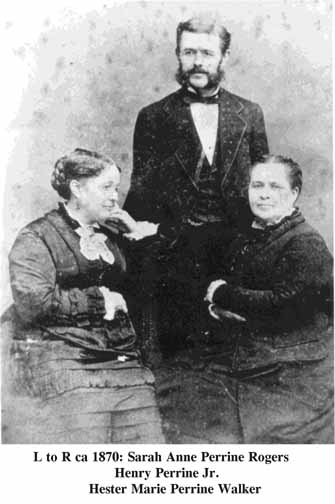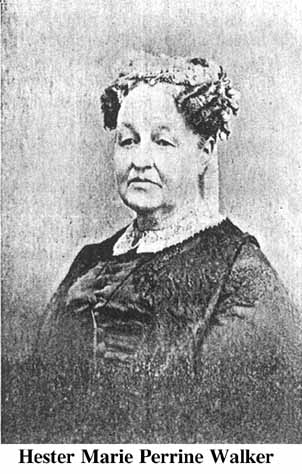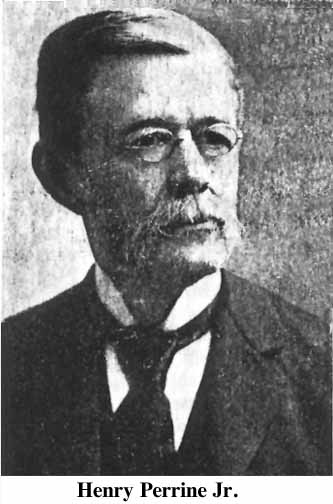DETAILS OF INDIAN KEY CONTINUED
DR. HENRY PERRINE OF INDIAN KEY
This page by Jerry WilkinsonHenry Edward Perrine was a descendant of a French Huguenot family who settled in New Jersey around 1665. He was born April 5, 1797 at Cranbury, New Jersey and taught school in Rockyhill, N.J. as a youth. He went on to study medicine and practiced for five years in Bond County, Illinois. While there he married Ann Fuller Townsend.
Not of great importance, however interesting, from Ripley, Illinois he wrote on November 15, 1820, "I came here on the 30th of September and got into business immediately .... By the first of this month I booked $200 of which $55 was in one day. Of that $55 I feel pretty certain of $33 which will make it a good day's work. About 22 miles above this is the new seat of Government laid out called Vandalia. A few reside there and by exposure several became sick. I was sent for to four and the fifth a Negro. By law I am allowed 50 cents a mile. That is $11 apiece exclusive of medicine..."
From a story written by his son, Dr. Perrine was seriously affected by accidental poisoning in 1821. The doctor had been taking a remedy of Peruvian bark to ward off malaria when a student accidentally left arsenic in the measuring glass from which he later drank. This accident was not part of his experiments. He never fully regained his strength and moved to Natchez, Mississippi in hope of improving his health. After three years he received the appointment as U.S. Consul at Campeche, Yucatan.
During his ten year stay in Mexico, he became interested in establishing a colony to grow tropical crops. He began collecting and shipping seeds to acquaintances in south Florida, one of them being Charles Howe at Indian Key.
When he returned to New Orleans he was offered LaFitte island which he refused and sailed for Indian Key, then to Washington promoting his request for a land grant. Stories vary about the one township (23,040 acres) grant which he received July, 1838. The Tropical Plant Company of Florida was formed with Dr. Perrine, Judge James Webb of Key West and Charles Howe, postmaster of Indian Key being its directors. Being advised of Indian hostilities on the mainland, he moved with his family to Indian Key on Christmas, 1838 where he died during the August 7, 1840 Indian attack.
A full account of the death of Dr. Perrine and the tribulations of his family is covered in detail on the page for the massacre.
To begin "the after part", I must digress a bit. Children Sarah Perrine was born March 24, 1823; Hester July 21, 1824 in Illinois and Henry Jr. March 20, 1827 in Sodus, N.Y.; therefore being 17, 16 and 13 years old at the time of the Indian attack.
After his death, Mrs. Perrine moved to Palmyra, N.Y. and was successful in persuading Congress to transfer the land rights to the Perrine family and the location of the grant was south of Miami. While there, Sarah married a Carter Rogers and Hester, a James Walker. Henry Jr. studied law and was accepted as a lawyer in 1848, the same year he met a Miss. Cordelia Hall. During this same period, his uncle Edwin, on his mother's side, was building a ship to move to California to build saw mills, a venture which Henry Jr. joined. Four years later, he married Cordelia.
The Howe children had also moved to Palmyra to go to school. Meanwhile, back in the Coconut Grove - Cutler area, Charles Howe, evidently with the cooperation of Mrs. Perrine, proceeded to try prove the Perrine land grant which required each of the 36 square miles be settled and cultivated by at least one family each. The year was about 1850. Florida had only been a state for five years and the settlement of Miami was still 46 years in the future.
Anyway, it is said that Howe obtained 36 Bahamian families to come over and do the work to prove the land patent. Evidently not much was done as when white settlers arrived after the War between the States, there were no Bahamians in that area. However, Congress held fast to allowing the Perrines to prove the claim.
In 1875, Henry Perrine Jr. gave up on California and seriously pursued settling the tract south of Miami. He offered free 20 acre tracts providing they would build a home, clear one acre and grow one tropical crop. Henry, himself with his two children Carleton and Harry, moved onto
the property in 1876 bringing considerable supplies. It was on this trip that he stopped by Indian Key for a return visit.
The Perrines set up a tent near the Addison family - who had been in the Cutler area for many years. As a northern attorney, Henry Jr. was beset immediately by the problems of living in a relative wilderness. He had only a handful of prospectors, ants attacked his food supply, the land was very rocky, funds ran out before a wharf could be completed and a hurricane destroyed what was completed. However, he was determined to establish his "Perrineville." Some of his crops were reasonably successful, but the only market was Key West. His prospectors branched out on their own and he threw in the towel after eight hard months.
Homesteaders were flocking to the south Dade area for free 160 acre tracts; however, Congress remained steadfast that the thirty-six square mile prime land tract was the Perrine Grant and not to be homesteaded. By 1886, many families had taken parts of the grant and built farms. They formed what was known as a "Squatter's Union" in order to protect their rights hiring Dr. Cutler as their representative.
The Florida Central and Peninsular Railroad and the Florida East Coast Railway joined with the Perrine family. One can imagine what ensued and in the end after going through a Senate investigation, on January 28, 1897, the settlers received a total of 2,000 acres, the Perrine heirs 10,000 acres and the two railroad companies 5,000 acres each.
Case closed? Wrong! The Charles Howe heirs, spearheaded by Henry A. Howe, sued everyone involved challenging that half of the Perrine land grant was theirs for their early involvement. In addition, the F.E.C. railroad planned to "cut down trees, destroy vegetation, dig up the soil and construct ditches and embankments ...to the permanent and irreparable injury of said land." Some of the settlers agreed having believed that the railroad would not proceed any farther south than Miami. An Orlando, Florida court ruled that the railroads and settlers could not be sued. The case was dismissed by the Supreme Court on November 11, 1898 and the railroad could proceed to build to Homestead. Land deeds were clouded for many years due to the lawsuits.
Mrs. Perrine died December 21, 1876; Sarah August 18, 1884; Hester April 11, 1879 and Henry Jr. May 30, 1901.
The Dade County settlement of Perrine remains as a reminder of Dr. Perrine. It came into existence in 1903 as a railroad camp for the F.E.C Extension to Homestead and opened its first school in 1909. Of the 72 exotic plants listed in Senate Document 300, 1838, Perrine's prized Aguave Sisalana (sisal hemp) now only grows wild. It is possible that the Key Lime evolved from one of the limes he brought in from Mexico.
For a longer biography of the man, Dr. Henry E. Perrine, Click HERE.Use the BACK ARROW to return to the previous page.
Continue TOUR to biography of Lt. John McLaughlin.
or
Return to Indian Key homepage
